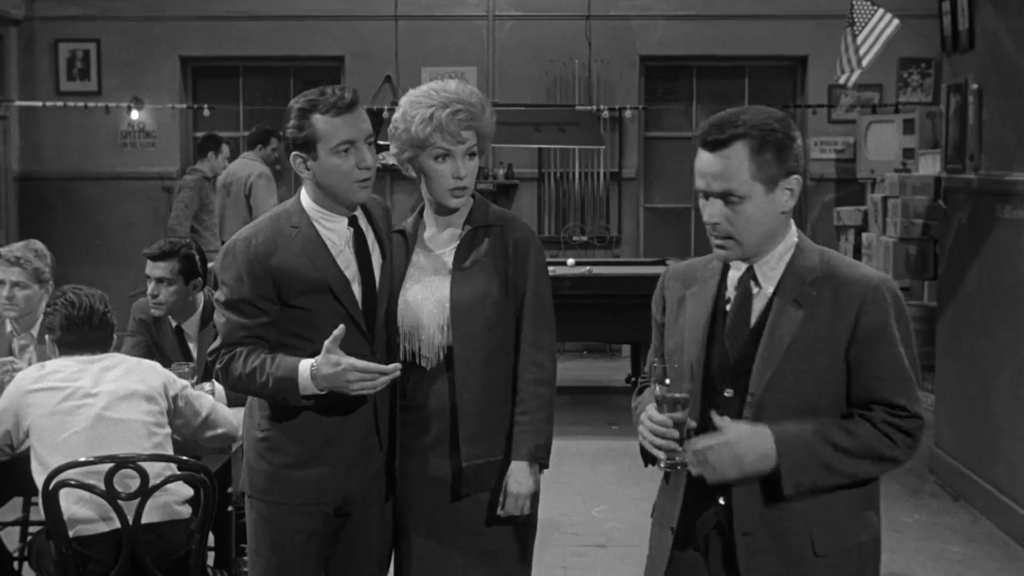
John Cassavetes is a filmmaker noted for his films with naturalistic acting, kinetic camera movements, and an emphasis on behaviorism over narrative motivation, and for being one of the first great American Independent filmmakers. From Faces (1968) to Love Streams (1984) these have been the defining attributes of Cassavetes’ cinema. This is precisely what makes Cassavetes’ first studio picture, Too Late Blues (1962), so remarkable in retrospect. To witness the director come into the maturity of Faces, to see where he pushed the envelope of commercial Hollywood filmmaking to usher in just a little bit more of his own style.
John Cassavetes began work on Too Late Blues at Paramount immediately after completing his second version of Shadows (1960). The territory of Hollywood filmmaking was not new to the director. He had acted in a number of Hollywood dramas by that point, most notably with directors Martin Ritt and Don Siegel. Cassavetes had also garnered some experience working the studio system when he directed a handful of episodes for a short-lived television series, Johnny Staccato,of which he was the star. So he wasn’t put off to find the mandates of the studio executives directing him to follow the modes of more conventional narrative filmmaking.
For the script of the film, Cassavetes collaborated with Richard Carr, constructing a narrative around Ghost (Bobby Darin), a small time jazz-band leader, and would-be blues singer Princess Polanski (Stella Stevens). The film follows the pair from love at first sight to break-up.
Thematically, this film is the originator of one of the most often reoccurring themes in all of Cassavetes’ films. That if one is to find financial success, one has to sell out both romantically and artistically, which is exactly what Ghost does. It’s clear from the many texts by Ray Carney available today that this was an opinion that Cassavetes steadfastly believed, but was also a moral question that constantly tugged at him. Surely, when mortgaging his house the second time to complete Faces he had doubts about whether his Romantic inclinations in art were justifiable. It must have seemed tremendously safer, financially speaking, to do thirty Dirty Dozens than one of his own pictures. But it was not Cassavetes’ way, and by the end of Too Late Blues it isn’t Ghost’s way either. As this moral dilemma recurred personally for Cassavetes, it creeps up time and again in his work such as in Faces, Husbands, A Woman Under The Influence, The Killing Of A Chinese Bookie, Opening Night, and finally Love Streams. All things considered, it is surprising that this theme should begin in Cassavetes’ first major studio work.
Themes and contexts are not the single reasons for the significance or brilliance of Too Late Blues, neither is it that this film marks the first time Seymour Cassel acted in one of Cassavetes’ films. Consider, after watching the film, when Cassavetes chose to implement the style of cinematography that defined Shadows. The quick jabs and pans of the hand held camera that electrify the frame with tense energy, and a raw realism. Cassavetes employs this style hardly ever. Mostly, the film frames its characters in long takes of wide shots or with long cut away shots in medium close-up. Cassavetes never gets as close to his subjects in Too Late Blues as he does in Faces, nor does he get as far away as he does on the beach in A Woman Under The Influence. But, the energy of Shadows is there. It creeps in, punctuating an action frames before it happens.
The best example comes near the end of the film. Ghost arrives at Reno’s Club. Across the bar sits his former lover Princess. This sequence begins with static shots, cutting from Darin to his eye line match, Stevens. Then, the film cuts to a shaky hand held shot, tracking backward, following Darin till he gets to Stevens and punches out a man who had been flirting with her. This description doesn’t do the moment justice, nor does it capture the surprise and energy of any of Cassavetes’ hand held shots. The sensation is alarming. These shots are so rare, but so well placed in Too Late Blues that they obtain their ultimate effect without relegating the film to “art houses”(not something the studios looked for in their films).
Too Late Blues is the turning point in Cassavetes’ early career as a filmmaker. It clearly demonstrates how he was then coming to master the tricks and tools of the industry. The next turning point would come the following year, directing A Child Is Waiting for Stanley Kramer. By then, Cassavetes would swear-off making studio pictures all together (though he didn’t always keep this promise), and would go on to make the films for which he is most famous.
